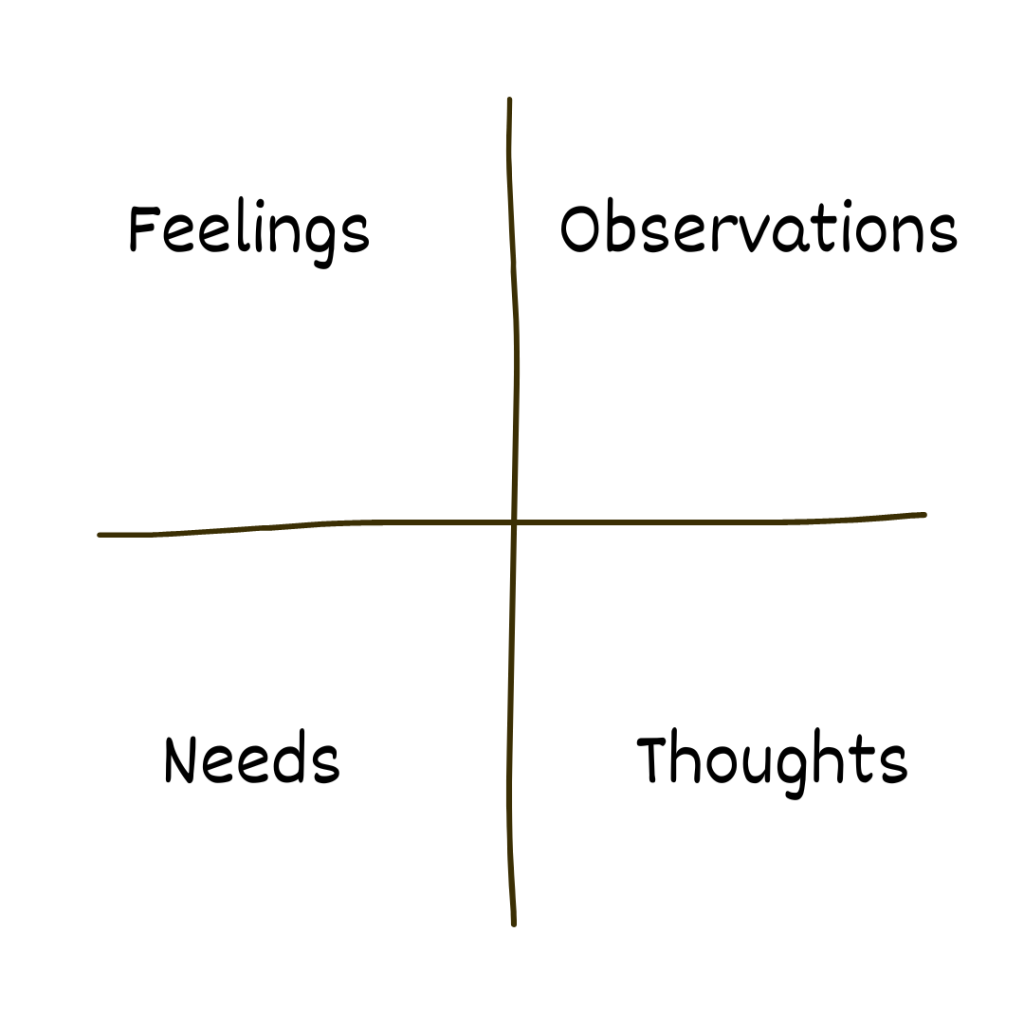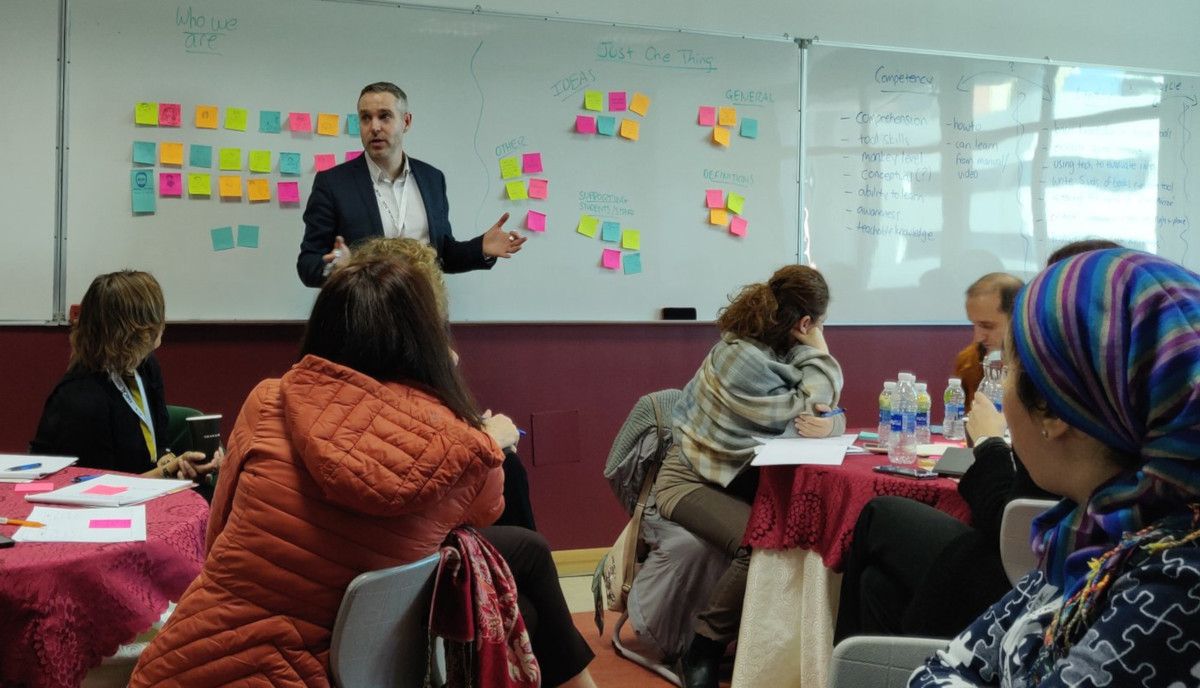FONT and Nonviolent Communication
It’s only Wednesday and I’ve had a couple of occasions this week to refer to Nonviolent Communication (NVC) and the FONT framework that I learned in workshops run by Outlandish. I’d highly recommend that you also attend their Reframing Conflict sessions.
I’m publishing this post so that I’ve got something to point people towards during conversations in which I reference FONT and NVC.
Let’s begin by defining terms:
Nonviolent Communication (NVC) is an approach to communication based on principles of nonviolence. It is not a technique to end disagreements, but rather a method designed to increase empathy and improve the quality of life of those who utilize the method and the people around them.
[…]
NVC is a communication tool with the goal of firstly creating empathy in the conversation. The idea is that once there is empathy between the parties in the conversation, it will be much easier to talk about a solution which satisfies all parties’ fundamental needs. The goal is interpersonal harmony and obtaining knowledge for future cooperation. Notable concepts include rejecting coercive forms of discourse, gathering facts through observing without evaluating, genuinely and concretely expressing feelings and needs, and formulating effective and empathetic requests.
Wikipedia
I have to be honest, I thought this was some real hippy-dippy stuff when I first read it. But the FONT framework in particular changed my mind. As Pete Burden and Abi Handley explain:
“FONT” is not a single model – it is a bricolage; it draws on:
Marshall Rosenberg’s Nonviolent Communication, Gervase Bushe’s Clear Language, Thomas Gordon’s work on I-statements and requests.
Ideas from several people (such as Bill Isaacs and Diana McLain Smith) at the MIT Dialogue and Harvard Negotiation projects ; David Grove’s Clean Language; Agazarian and Simon’s System for Analysing Verbal Interaction (SAVI™); Bill Torbert’s collaborative enquiry.
And work by Arnold Mindell, Bob Kegan, Carl Rogers, David Cooperrider, David Kantor, Douglas Stone, Lisa Lahey, Mary Follett, Reg Revans, Robert Plutchik, Stephen Hayes, Susan Wheelan, Richard Schwartz and many, many more.
So what is it? How does it work?

FONT is an easy way to remember the four constituent parts, but when you use this as an approach, you actually use it in this order:
- Observations — what actually happened, without emotion
- Thoughts — what you think about the situation
- Feelings — how that made you feel
- Needs — what you need or want from the situation
Since I attended the workshop, I’ve used this approach in both professional and personal conflict situations. Sometimes I’ve done it verbally, starting with “I noticed that…” whereas other times I’ve gone through the FONT process in written form to prepare me for a potentially-awkward conversation.
Step-by-step approach
Step 1: Observe the situation objectively — focus on the specific behaviour that’s causing the issue, rather than making assumptions or jumping to conclusions. For example, if a colleague is frequently interrupting you during meetings, observe that behaviour without making any assumptions about their intentions or motivations.
Step 2: State your thoughts — try and articulate what you are thinking or have noticed in an uncontroversial way. For example, you could say to your colleague, “I notice that you often have a lot that you want to communicate during meetings.”
Step 3: Identify your feelings — are you feeling frustrated, angry, or upset? By identifying your emotions, you can communicate more effectively and avoid becoming defensive or confrontational. For example, you might say “I feel frustrated when you interrupt me during meetings because I want to make sure my ideas are heard.”
Step 4: Articulate your needs — what do you need in order to feel more comfortable or productive in the situation? This is an opportunity to express your needs in a positive and constructive way. For example, you might say “I need to have uninterrupted speaking time during meetings so that I can share my ideas and feel heard.”
Step 5: Make a request — this is an opportunity to ask for what you need in a constructive and positive way. For example, you might say “can we agree that everyone will have an opportunity to speak uninterrupted during our meetings?”
As a side note, it’s worth mentioning that “I noticed that…” is a bit of a magic phrase. For example, there are cars which travel too fast down the 20mph street next to my house. I tend to get annoyed at this and have a tendency to shout at the drivers, but my neighbour has a better approach. He smiles, asks them to wind down their window, and says something like, “I noticed that you seemed to be in a hurry?” His going on to explain that the road has a 20mph speed limit feels overall like a less confrontational approach.
In closing, one of the things I’ve learned during my career to date is that coercion and manipulation tends is a hallmark of hierarchical and paternalist organisations. We can do without it:
Nonviolent Communication holds that most conflicts between individuals or groups arise from miscommunication about their human needs, due to coercive or manipulative language that aims to induce fear, guilt, shame, etc. These “violent” modes of communication, when used during a conflict, divert the attention of the participants away from clarifying their needs, their feelings, their perceptions, and their requests, thus perpetuating the conflict.
Wikipedia
People may bristle at the accusation that many of our ‘normal’ ways of communication tend to be violent but, it’s worth thinking about adding the FONT framework and nonviolent communication techniques to our toolboxes. I think my family, friends, and colleagues would still say I’m perhaps a little too quick to anger, but at least I now have tools to defuse situations that would previously feel out of my control!

